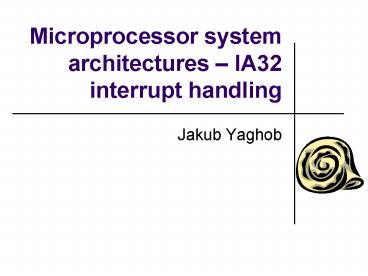Microprocessor system architectures IA32 interrupt handling - PowerPoint PPT Presentation
1 / 21
Title:
Microprocessor system architectures IA32 interrupt handling
Description:
Some exceptions store error code on the top of the stack ... IRET behaves differently (always pops SS:RSP) New interrupt stack mechanism ... – PowerPoint PPT presentation
Number of Views:349
Avg rating:3.0/5.0
Title: Microprocessor system architectures IA32 interrupt handling
1
Microprocessor system architectures IA32
interrupt handling
- Jakub Yaghob
2
Overview
- Sources of interrupts and exceptions
- External HW interrupt, asynchronous, maskable
- SW interrupt caused explicitly and synchronous
using the instructions INTn, INT3 and INTO - Exception generated by CPU, when it detects
some error - Vector system
- IDT (Interrupt Descriptor Table)
- Address and size provided in IDTR
- Each handled event has assigned its vector number
8-bit number (0-255) - Exceptions have fixed vector numbers in IA-32
- Assignment of vector numbers for HW interrupts
leaved on external circuits - PIC, APIC
3
IDT Interrupt Descriptor Table
- IDT
- As a matter of form similar to GDT
- Descriptor table
- Only task-gate, interrupt-gate, trap-gate
- Loading IDTR similar to GDTR
- The size of IDT is max. 2568
- Can be smaller
- In contrast to GDT, the IDT has valid vector
number 0
4
Interrupt handling
- Identify the vector number
- External supplied by interrupt controller using
a bus protocol - NMI taken as an exception
- Exception fixed vector number by architecture
- SW interrupt vector number encoded explicitly
or implicitly in the instructions INTn, INT3 and
INTO - Indexing IDT using vector number
- Using a gate in the IDT
- The test EPL DPL for a gate computed only for
instructions INTn, INT3 and INTO
5
Disabling and enabling interrupts
- Only for external maskable HW interrupts
- Changing IF
- Instructions CLI, STI for CPL IOPL
- POPF, silently ignored for CPL gt IOPL
- Task switch, return from interrupt IRET
- Interrupt handling using interrupt-gate
- Masking interrupts and exceptions when switching
stack - Atomic change of SSESP
- MOV/POP SS disable external interrupts and debug
exception until the end of the next instruction - All other exceptions use the old SSESP
6
Priority
7
Gates I
8
Gates II
- Gates behavior
- Nearly the same like the call-gate
- No parameter copying
- EFLAGS automatically stored on the stack
- Changing EFLAGS content
- Clearing flags TF, VM, RF, NT
- Interrupt-gate clears IF
- Some exceptions store error code on the top of
the stack - It is the property of an exception, not a gate
9
Stack
10
Exceptions
- Reserved range of vector numbers 0-31
- Classification
- TRAP
- State report
- Reported immediately after the execution of the
instruction - FAULT correctable errors
- Reported before the instruction
- Instruction restart
- ABORT unrecoverable errors
- It is not usually possible to discover the exact
instruction location - HW errors
- Inconsistent system tables
11
Error code
- EXT external event
- IDT selector from IDT
- TI LDT/GDT (IDT0)
12
Exceptions I
13
Exceptions II
14
Double fault DF
- The second exception calling an exception handler
for a prior exception - Interrupts divided into 3 classes
- Benign 1-7, 9, 16-19, INTn, INTR
- Contributory 0, 10-13
- Page fault 14
15
Invalid TSS TS I
16
Invalid TSS TS II
17
Page fault PF
- CR2 contains linear address which generated the
exception - Conditions
- The P flag in any page table level is cleared
- Insufficient access rights
- Access a page with CPL3 and U/S0
- Write to page with CPL3 and R/W0
- Write to page with CPL0-2 and R/W0 and CR0WP
0 (from Pentium above) - Execution from page with NX1
- Any reserved bit set to 1
18
Page fault error code
19
Exceptions and interrupt handling in the long mode
- Like in 32-bit mode with following exceptions
- All interrupt handlers in IDT are in 64-bit code
- Stack is 64-bit wide
- SSRSP always pushed
- New SS is NULL when CPL changes
- IRET behaves differently (always pops SSRSP)
- New interrupt stack mechanism
- The alignment of stack is different (16-bytes-XMM
registers)
20
Interrupt/trap gate 64b
21
Interrupt stack table
- Individually enabled in descriptors
- Part of the 64-bit TSS
- 7 new stacks
- IST0 means old stack mechanism
- Calling interrupt handler
- RSP loaded from TSSIST
- SS forced to NULL with RPL set to the new CPL
- Old SS, RSP, RFLAGS, CS, RIP pushed on the new
stack

